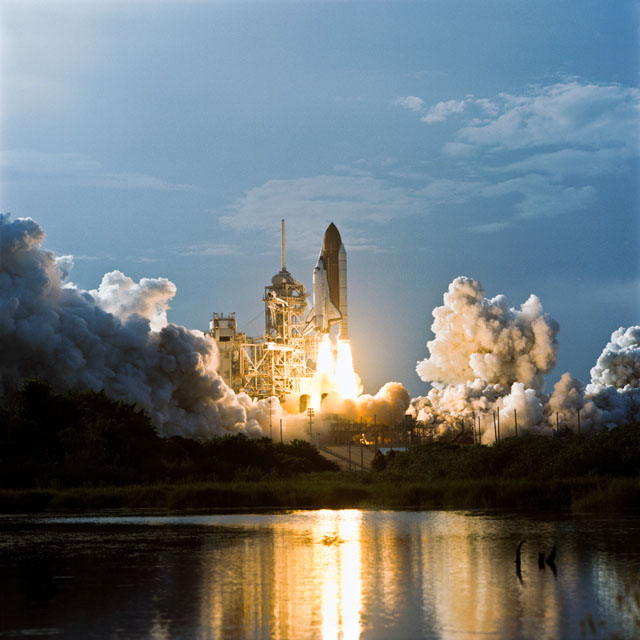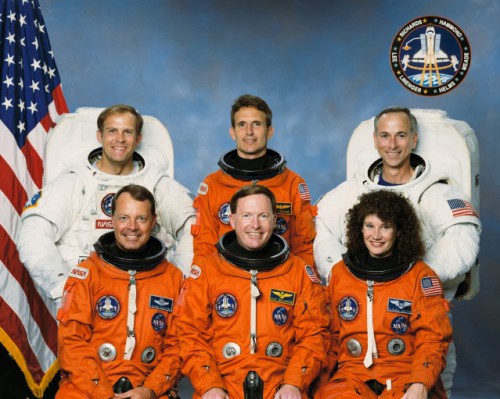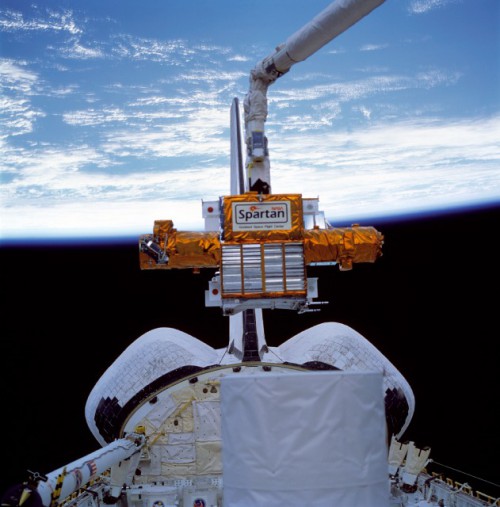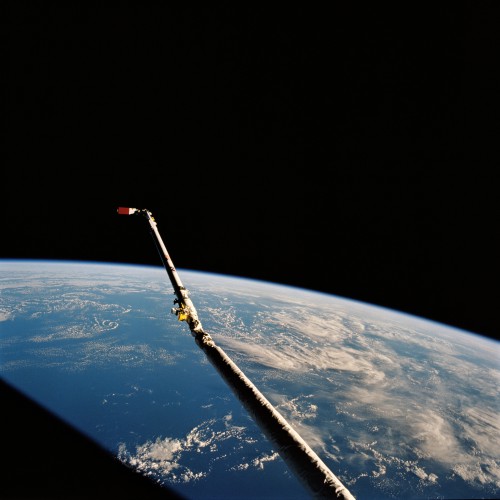
One hundred and twenty-three times before 16 September 1994, astronauts and cosmonauts had clambered outside their space ships and maneuvered themselves around in the harsh and unforgiving vacuum of space. They had used handholds, they had used tethers, and they had used specialized maneuvering units to prevent them from losing contact with their vehicles and floating away into the void. When STS-64 astronauts Mark Lee and Carl Meade ventured outside Shuttle Discovery’s airlock on the morning of that fall day in 1994—20 years ago, next week—they wore something quite different and entirely new on their space suits. As described in yesterday’s AmericaSpace history article, the “Simplified Aid for EVA Rescue” (SAFER) cost $7 million to develop and its descendents are today utilized aboard the International Space Station (ISS).
Aside from the ambitious spacewalk, the primary objectives of STS-64 were the deployment and recovery of the Shuttle-Pointed Autonomous Research Tool for Astronomy (SPARTAN)-201, with its battery of solar physics instruments—previously flown aboard STS-56 in April 1993—and the operation of the Lidar In-Space Technology Experiment (LITE). The latter was originally slated for two shuttle missions in the 1994-95 timeframe, but ultimately flew just once, as several “stand-alone” primary payloads haemorrhaged from the manifest in response to the growing shuttle-Mir effort. Developed by NASA’s Office of Advanced Concepts and Technology and Mission to Planet Earth, the 5,900-pound (2,680-kg) LITE instrument took the form of a lidar device to transmit narrow pulses of laser light into Earth’s atmosphere and used a telescope to measure the reflectance qualities from clouds, suspended aerosol particles, and the surface itself. The usefulness of lidar as a remote-sensing tool derived from the fact that it could obtain very high vertical and horizontal resolutions, and LITE marked the first occasion on which lidar had ever been employed in space for atmospheric observations.
More than 43 hours of data were gathered and Discovery’s relatively low-altitude of 160 miles (260 km) and high inclination of 57 degrees to the equator enabled LITE to cover a broad swathe of the Home Planet. Simultaneously, on the ground and in the air, investigators at more than 50 sites in 20 discrete countries made their own complementary observations. Five international aircraft flew directly “beneath” portions of Discovery’s flight path, covering parts of Europe, the southwestern United States, the Caribbean, South America, and the South Atlantic. Mounted on a Spacelab pallet, LITE gathered its data during a series of 10 sessions, each lasting 4.5 hours, as well as performing a handful of 15-minute “snapshots” of selected target sites. (These snapshot sites yielded “ground-truth” comparison points and included a lidar situated at NASA’s Langley Research Center in Hampton, Va.) The returning lidar signals were converted to digital data and stored on tapes aboard Discovery for transmission to the ground.

“Lasers … produce a tight, coherent beam that spreads very little as it travels from its source, compared to ordinary light,” noted NASA’s pre-mission press kit. “From its orbital altitude, LITE’s laser beam would spread to only about 980 feet (300 meters) wide at the surface. This allows the LITE instrument to measure a very small, narrowly-defined column of the atmosphere with each pulse.” With pulses transmitted 10 times per second, and each lasting less than 30 billionths of a second, at precisely-known wavelengths corresponding to ultraviolet, infrared, and visible green light, it was possible to achieve a resolution of about 49 feet (15 meters). By the end of the first day of the mission, the LITE ground team was reporting “terrific-looking returns” from the instrument.
Operating throughout the mission—with operations temporarily suspended whilst Lee and Meade performed their EVA—the LITE instrument investigated the organization of cloud structures in the Western Pacific Ocean, together with cloud decks off the coasts of California and Peru, smoke plumes from biomass fires in South America and Africa, and the transport of dust from the Sahara Desert. Additionally, low-atmosphere aerosols were examined over the Amazon rainforest and gravity waves (a mechanism that transfers momentum from the troposphere to the stratosphere) over the Andes and the reflection characteristics of desert surfaces in the United States, Africa, and China. LITE also dramatically outlined the structure of Super-Typhoon Melissa, providing unprecedented views of the storm’s eye. It was expected that the technology demonstration could lead to future satellites to perform year-round lidar observations of clouds, urban smog, or dust storms.
The LITE instrument took the form of a 3.3-foot-diameter (1-meter) telescope and optics package with photomultiplier tubes to provide its visible green and ultraviolet sensitivity and a silicon avalanche photodiode for its infrared capability. Interestingly, the telescope was actually an engineering model from NASA’s 1960s-era Orbiting Astronomical Observatory (OAO) program, and its use for LITE reportedly saved the space agency an estimated $8 million. In spite of periodic laser shutdowns, caused by coolant-loop problems, NASA noted in its post-mission report that the system “performed more effectively than originally expected, demonstrating the ability of a lidar…to penetrate multiple clouds and aerosol layers down to the Earth’s surface.”
Although the six STS-64 crew members looked visibly identical to their predecessors when they left the Kennedy Space Center’s (KSC) Operations and Checkout Building, bound for the launch pad, on 9 September 1994, they were in fact clad in upgraded versions of the pressure suits worn in the wake of the Challenger accident. The new Model S1035 Advanced Crew Escape Suit (ACES)—popularly nicknamed “the pumpkin suit,” owing to its bright “international orange” color—was a direct descendent of U.S. Air Force high-altitude garments worn by SR-71 Blackbird pilots and, latterly, of the Launch and Entry Suits (LES) worn by each shuttle crew since STS-26.

Manufactured by the David Clark Company of Worcester, Mass., the new suit differed from the LES in that it operated at full (rather than partial) pressure. “It was always realized,” wrote Dennis Jenkins in his monumental history of the shuttle, “that the LES was not the optimum suit and in 1990 a new development effort was initiated that resulted in the Model S1035 ACES … designed to be simplified, lightweight, low-bulk, full-pressure … that facilitated self-donning/doffing and provided enhanced overall performance.” The first ACES units were delivered to NASA in May 1994. They boasted gloves on disconnecting wrist-rings, better liquid cooling and ventilation, and extra insulation. Oxygen was fed into the suit through a connector at the left thigh and transmitted to the helmet via the base of the neck ring. Textured glove palms offered a measure of dexterity and flexion, particularly for the commander and pilot when operating the stick, whilst heavy leather “paratrooper” boots with zippers, a survival backpack with life raft, and emergency light sticks completed the fully-equipped 92-pound (41.7-kg) ensemble.
Liftoff of STS-64 occurred at 6:22 p.m. EDT on 9 September 1994, very close to the end of that day’s “window,” which opened at 4:30 p.m. and was due to close at 7:00 p.m. Launching late in the day came a pleasant surprise for many of the crew—Commander Dick Richards, Pilot Blaine Hammond, and Mission Specialists Jerry Linenger, Susan Helms, Carl Meade, and Mark Lee—who had participated in around-the-clock flights earlier in their careers, as it required little in the way of “sleep-shifting.” The late afternoon launch was required in order to permit “night” operations of LITE early in the mission, but weather violations close to Pad 39B required the six astronauts to wait uncomfortably on their backs for almost two hours later than planned. Until relatively late in the countdown, Launch Commit Criteria remained “Red” (“No-Go”) for flight through clouds greater than 45,000 feet (13,700 meters) and flight through thunderstorm clouds.
Upon arrival in orbit, however, the entire crew moved crisply about their tasks. By the time of Lee and Meade’s EVA on the 16th, LITE operations were well underway and the second primary objective of the mission—the deployment and retrieval of SPARTAN-201— had also been successfully concluded. On 13 September, Helms lifted the boxy satellite out of Discovery’s payload bay with the Canadian-built Remote Manipulator System (RMS) mechanical arm and released it into space at 5:30 p.m. EDT. It spent the next two days performing observations of the solar corona with its twin instruments, a White Light Coronagraph and an Ultraviolet Coronal Spectrometer. “After we left it, we did not really see it again, until our rendezvous sequence,” Helms related in the post-mission press conference. “It was out of our field of view.”

During the deployment, however, data from Discovery’s Ku-band rendezvous radar exhibited “questionable readings,” which Mission Control attributed to a late acquisition of SPARTAN. An hour after the satellite’s release, the radar passed several self-tests, without obvious problems, but according to NASA’s post-mission report, “multiple searches were performed in both the General Purpose Computer and Automatic modes … all without success.” Finally, an hour after the deployment, the Ku-band successfully acquired the SPARTAN and remained locked onto its target until the Communications Mode was selected. However, as a contingency measure, and in case the radar was unavailable for retrieval, plans were developed for a “workaround” rendezvous profile on 15 September, possibly incorporating ground-based navigation data and the shuttle’s own star trackers.
“These procedures are not as precise and would require slightly more propellant than normal,” noted a Mission Control Center Status Report on the evening of the 14th, but acquiesced that “the propellant margins are adequate to support a ‘no-radar’ rendezvous and the crew and flight control teams are trained for such a scenario.” As the situation evolved over the following hours, the radar posed no further difficulties, and from a distance of 24 miles (39 km) to just 82 feet (25 meters) it guided Dick Richards perfectly into position for him to complete proximity operations and for Helms to grapple the satellite.
Elsewhere in the payload bay, aboard two Getaway Special (GAS) canisters, the Robot-Operated Materials Processing System—saddled with the rather questionable acronym of “ROMPS”—marked another “first” of STS-64, in that it represented the first robotic processing of semiconductors in space. The experiment employed a robot to transfer 100 sample “pellets” from storage racks into small halogen-lamp furnaces, where their crystalline structures were re-formed in heating and cooling cycles. A 33-foot (10-meter) instrumented extension boom for the RMS arm, known as the Shuttle Plume Impingement Flight Experiment (SPIFEX), was tested to gather data about the effect of 86 thruster firings upon large structures, whilst 10 GAS canisters on a cross-bay bridge housed experiments in ozone-monitoring, the growth of seeds, the behavior of insects, the formation of superconductors, crystal growth, solar observations, and materials science. These GAS payloads represented a wide range of investigators and a wide range of age groups, from young schoolchildren to higher academic institutions, and came from as far afield as Canada, China, Japan, and The Netherlands, as well as the United States.
The mission had already been extended from nine to 10 days, but the scheduled touchdown at KSC’s Shuttle Landing Facility on 19 September dawned gloomy, with thunderstorms and low, thick cloud cover. Two opportunities existed to land in Florida on the 20th, together with two more at Edwards Air Force Base, Calif., and although Florida was the preferred option the weather finally turned against STS-64. Rain showers along the Space Coast made even the 20th a “No-Go” in terms of Mother Nature and Dick Richards and his crew were diverted to California. Under picture-perfect skies, Discovery swooped onto Runway 04 at Edwards at 2:12 p.m. PDT (5:12 p.m. EDT), concluding a voyage of a little less than 11 full days. The mission had put virtually all of the shuttle’s capabilities—satellite deployment and retrieval, scientific research, multiple payloads, proximity operations, and EVA—to the test and served to prepare the fleet for space station construction.
This is part of a series of history articles, which will appear each weekend, barring any major news stories. Next week’s article will focus on STS-48, a shuttle flight from September 1991 which placed NASA’s Upper Atmosphere Research Satellite (UARS) into orbit.
Want to keep up-to-date with all things space? Be sure to “Like” AmericaSpace on Facebook and follow us on Twitter: @AmericaSpace



